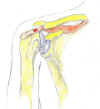
The rotator cuff does not slide smoothly under the acromion and coraco-acromial ligament at this state at abduction. In the case of excessive friction between the rotator cuff and these stiff structures, a chronic pressure damage of the rotator cuff occurs. The affection is also highlighted with the fact that in this area blood of the rotator cuff (tendons m. supraspinatus) is the least, and therefore reparative processes are slower. We think that a constriction of this space often origins on the basis of arthrosis and synovitis of the enlarged acromioclavicular articulation.
This process can clinically manifest itself as a painful arc15. In the case of an abduction of the shoulder girdle, a pain is called up till a certain angle, during which the rotator cuff is nipped. This pain lasts till the head of the humerus does not slip under the acromion, and the abduction already continues without any pain, see following pictures.
In the rest, the area with inflamation is located distally from the acromion and the pain isnt present
During the abduction the akromion ( often akromioclavikular joint enlarged by osteoarthritis ) make pressure on the demaged muscle or tendon and causes pain
This pain lasts till the head of the humerus does not slip under the acromion, and the abduction already continues without any pain, see following pictures.
In literature there are mentioned clinical tests on the impigement syndrome which are not, in our opinion, wholly specific, and there is no reason to make them.
![]()
15 but this symptom is not specific, and another cause of the problems must be eliminated – ultrasound examination is always necessary